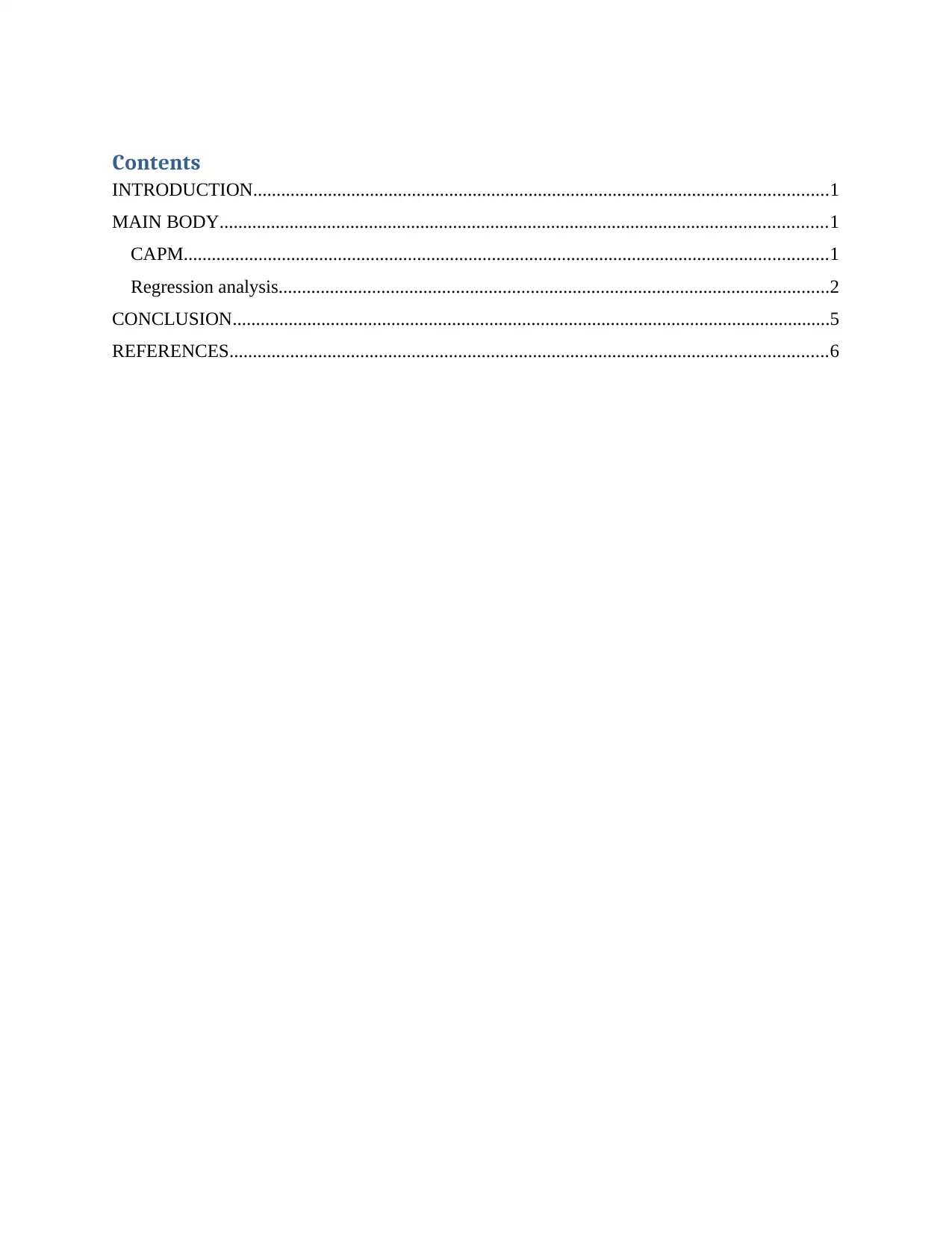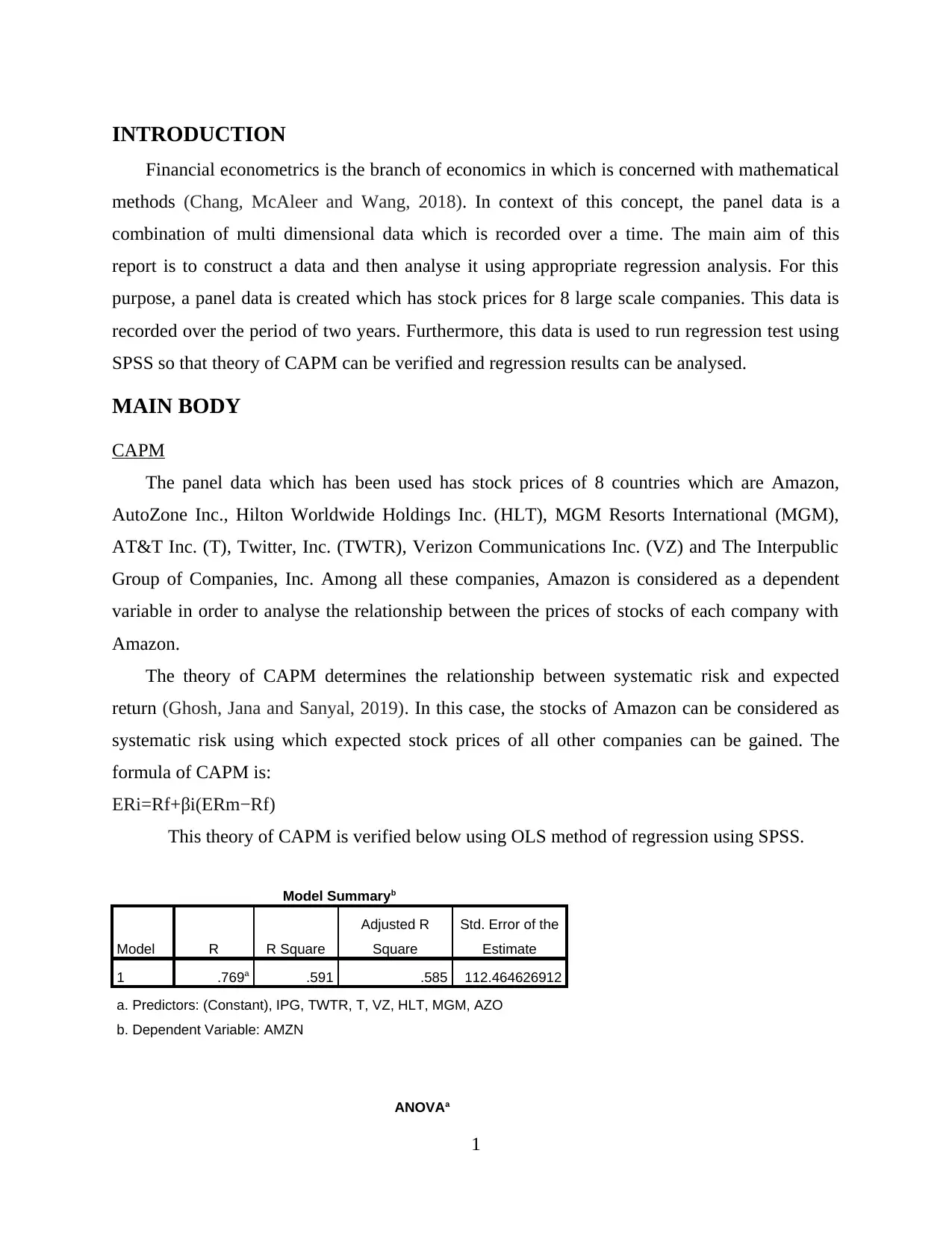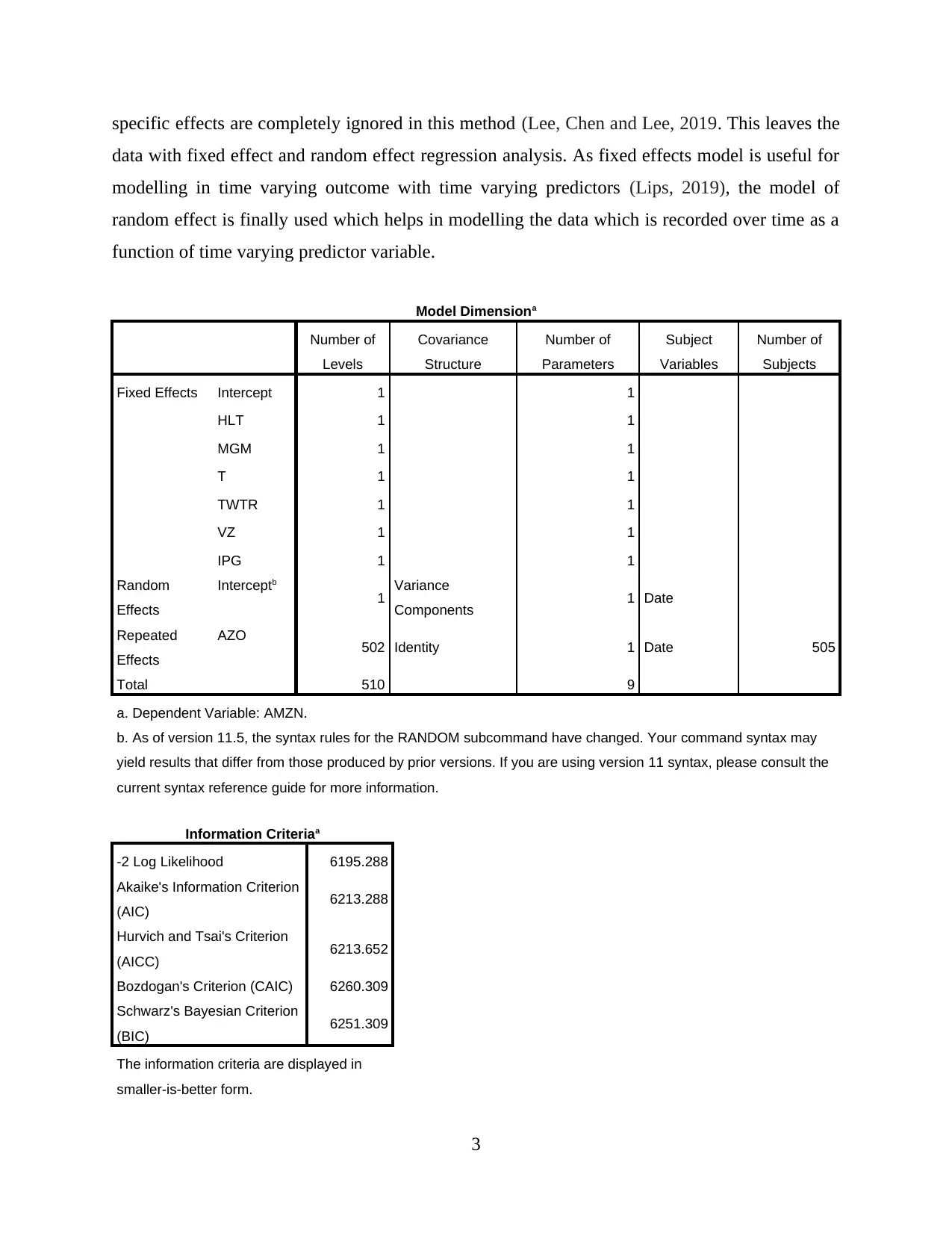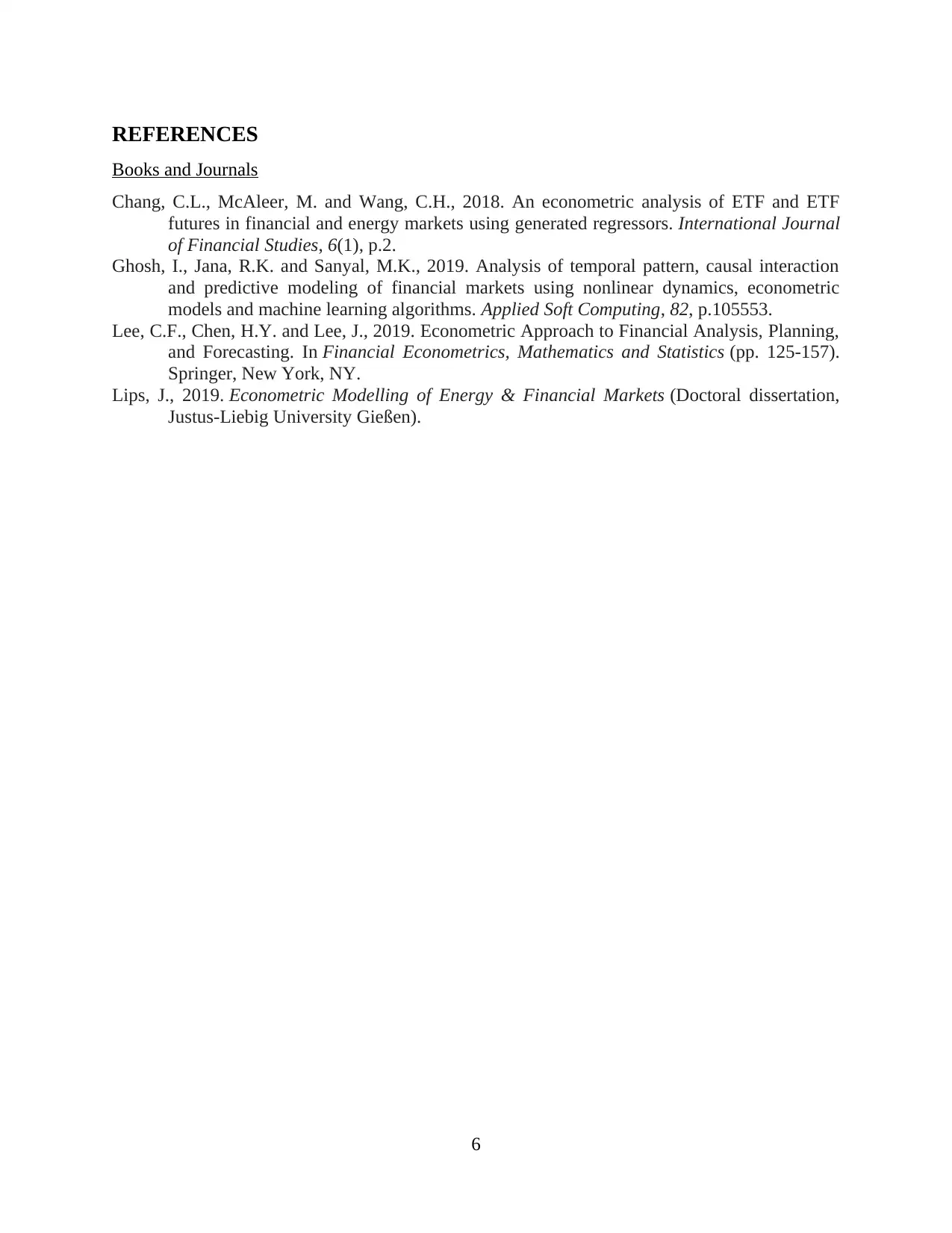Financial Econometrics: CAPM Verification and Regression Results
VerifiedAdded on 2023/01/12
|8
|1392
|22
Report
AI Summary
This report delves into the realm of financial econometrics, employing panel data analysis to verify the Capital Asset Pricing Model (CAPM). The study constructs a panel dataset comprising stock prices from eight prominent US companies, including Amazon, AutoZone, and others, over a two-year period. The analysis utilizes regression techniques, specifically OLS, FE, and RE estimators, to assess the relationship between the stock prices and the systematic risk as defined by CAPM. The report provides a detailed discussion of the regression results, determining the most appropriate model for the data and offering insights into the validity of CAPM in the context of the selected companies. The findings highlight the significance of the relationship between Amazon's stock prices and the stock prices of the other companies, providing a comprehensive understanding of the financial dynamics involved.

Financial econometric
Paraphrase This Document
Need a fresh take? Get an instant paraphrase of this document with our AI Paraphraser

Contents
INTRODUCTION...........................................................................................................................1
MAIN BODY..................................................................................................................................1
CAPM..........................................................................................................................................1
Regression analysis......................................................................................................................2
CONCLUSION................................................................................................................................5
REFERENCES................................................................................................................................6
INTRODUCTION...........................................................................................................................1
MAIN BODY..................................................................................................................................1
CAPM..........................................................................................................................................1
Regression analysis......................................................................................................................2
CONCLUSION................................................................................................................................5
REFERENCES................................................................................................................................6

INTRODUCTION
Financial econometrics is the branch of economics in which is concerned with mathematical
methods (Chang, McAleer and Wang, 2018). In context of this concept, the panel data is a
combination of multi dimensional data which is recorded over a time. The main aim of this
report is to construct a data and then analyse it using appropriate regression analysis. For this
purpose, a panel data is created which has stock prices for 8 large scale companies. This data is
recorded over the period of two years. Furthermore, this data is used to run regression test using
SPSS so that theory of CAPM can be verified and regression results can be analysed.
MAIN BODY
CAPM
The panel data which has been used has stock prices of 8 countries which are Amazon,
AutoZone Inc., Hilton Worldwide Holdings Inc. (HLT), MGM Resorts International (MGM),
AT&T Inc. (T), Twitter, Inc. (TWTR), Verizon Communications Inc. (VZ) and The Interpublic
Group of Companies, Inc. Among all these companies, Amazon is considered as a dependent
variable in order to analyse the relationship between the prices of stocks of each company with
Amazon.
The theory of CAPM determines the relationship between systematic risk and expected
return (Ghosh, Jana and Sanyal, 2019). In this case, the stocks of Amazon can be considered as
systematic risk using which expected stock prices of all other companies can be gained. The
formula of CAPM is:
ERi=Rf+βi(ERm−Rf)
This theory of CAPM is verified below using OLS method of regression using SPSS.
Model Summaryb
Model R R Square
Adjusted R
Square
Std. Error of the
Estimate
1 .769a .591 .585 112.464626912
a. Predictors: (Constant), IPG, TWTR, T, VZ, HLT, MGM, AZO
b. Dependent Variable: AMZN
ANOVAa
1
Financial econometrics is the branch of economics in which is concerned with mathematical
methods (Chang, McAleer and Wang, 2018). In context of this concept, the panel data is a
combination of multi dimensional data which is recorded over a time. The main aim of this
report is to construct a data and then analyse it using appropriate regression analysis. For this
purpose, a panel data is created which has stock prices for 8 large scale companies. This data is
recorded over the period of two years. Furthermore, this data is used to run regression test using
SPSS so that theory of CAPM can be verified and regression results can be analysed.
MAIN BODY
CAPM
The panel data which has been used has stock prices of 8 countries which are Amazon,
AutoZone Inc., Hilton Worldwide Holdings Inc. (HLT), MGM Resorts International (MGM),
AT&T Inc. (T), Twitter, Inc. (TWTR), Verizon Communications Inc. (VZ) and The Interpublic
Group of Companies, Inc. Among all these companies, Amazon is considered as a dependent
variable in order to analyse the relationship between the prices of stocks of each company with
Amazon.
The theory of CAPM determines the relationship between systematic risk and expected
return (Ghosh, Jana and Sanyal, 2019). In this case, the stocks of Amazon can be considered as
systematic risk using which expected stock prices of all other companies can be gained. The
formula of CAPM is:
ERi=Rf+βi(ERm−Rf)
This theory of CAPM is verified below using OLS method of regression using SPSS.
Model Summaryb
Model R R Square
Adjusted R
Square
Std. Error of the
Estimate
1 .769a .591 .585 112.464626912
a. Predictors: (Constant), IPG, TWTR, T, VZ, HLT, MGM, AZO
b. Dependent Variable: AMZN
ANOVAa
1
You're viewing a preview
Unlock full access by subscribing today!

Model Sum of Squares df Mean Square F Sig.
1 Regression 9085279.928 7 1297897.133 102.614 .000b
Residual 6286201.276 497 12648.292
Total 15371481.204 504
a. Dependent Variable: AMZN
b. Predictors: (Constant), IPG, TWTR, T, VZ, HLT, MGM, AZO
Coefficientsa
Model
Unstandardized Coefficients
Standardized
Coefficients
t Sig.B Std. Error Beta
1 (Constant) 781.446 212.000 3.686 .000
AZO -.065 .109 -.071 -.595 .552
HLT 9.861 1.584 .554 6.226 .000
MGM -36.312 3.622 -.665 -10.027 .000
T 2.004 3.407 .033 .588 .557
TWTR 6.721 1.136 .202 5.919 .000
VZ -1.064 3.291 -.025 -.323 .747
IPG 43.942 5.850 .272 7.512 .000
a. Dependent Variable: AMZN
Residuals Statisticsa
Minimum Maximum Mean Std. Deviation N
Predicted Value 1335.06164551 1993.18969727 1714.88401990 134.262239901 505
Residual -290.797943115 314.391052246 .000000000 111.680891740 505
Std. Predicted Value -2.829 2.073 .000 1.000 505
Std. Residual -2.586 2.795 .000 .993 505
a. Dependent Variable: AMZN
From the above results presented in coefficients, it is clear that by using beta, and market
risk and market risk premium, the expected return can be estimated.
Regression analysis
It is important to choose an appropriate method for the regression analysis. For the panel
data created, method of liner regression or OLS has been eliminated as all the individually
2
1 Regression 9085279.928 7 1297897.133 102.614 .000b
Residual 6286201.276 497 12648.292
Total 15371481.204 504
a. Dependent Variable: AMZN
b. Predictors: (Constant), IPG, TWTR, T, VZ, HLT, MGM, AZO
Coefficientsa
Model
Unstandardized Coefficients
Standardized
Coefficients
t Sig.B Std. Error Beta
1 (Constant) 781.446 212.000 3.686 .000
AZO -.065 .109 -.071 -.595 .552
HLT 9.861 1.584 .554 6.226 .000
MGM -36.312 3.622 -.665 -10.027 .000
T 2.004 3.407 .033 .588 .557
TWTR 6.721 1.136 .202 5.919 .000
VZ -1.064 3.291 -.025 -.323 .747
IPG 43.942 5.850 .272 7.512 .000
a. Dependent Variable: AMZN
Residuals Statisticsa
Minimum Maximum Mean Std. Deviation N
Predicted Value 1335.06164551 1993.18969727 1714.88401990 134.262239901 505
Residual -290.797943115 314.391052246 .000000000 111.680891740 505
Std. Predicted Value -2.829 2.073 .000 1.000 505
Std. Residual -2.586 2.795 .000 .993 505
a. Dependent Variable: AMZN
From the above results presented in coefficients, it is clear that by using beta, and market
risk and market risk premium, the expected return can be estimated.
Regression analysis
It is important to choose an appropriate method for the regression analysis. For the panel
data created, method of liner regression or OLS has been eliminated as all the individually
2
Paraphrase This Document
Need a fresh take? Get an instant paraphrase of this document with our AI Paraphraser

specific effects are completely ignored in this method (Lee, Chen and Lee, 2019. This leaves the
data with fixed effect and random effect regression analysis. As fixed effects model is useful for
modelling in time varying outcome with time varying predictors (Lips, 2019), the model of
random effect is finally used which helps in modelling the data which is recorded over time as a
function of time varying predictor variable.
Model Dimensiona
Number of
Levels
Covariance
Structure
Number of
Parameters
Subject
Variables
Number of
Subjects
Fixed Effects Intercept 1 1
HLT 1 1
MGM 1 1
T 1 1
TWTR 1 1
VZ 1 1
IPG 1 1
Random
Effects
Interceptb
1 Variance
Components 1 Date
Repeated
Effects
AZO 502 Identity 1 Date 505
Total 510 9
a. Dependent Variable: AMZN.
b. As of version 11.5, the syntax rules for the RANDOM subcommand have changed. Your command syntax may
yield results that differ from those produced by prior versions. If you are using version 11 syntax, please consult the
current syntax reference guide for more information.
Information Criteriaa
-2 Log Likelihood 6195.288
Akaike's Information Criterion
(AIC) 6213.288
Hurvich and Tsai's Criterion
(AICC) 6213.652
Bozdogan's Criterion (CAIC) 6260.309
Schwarz's Bayesian Criterion
(BIC) 6251.309
The information criteria are displayed in
smaller-is-better form.
3
data with fixed effect and random effect regression analysis. As fixed effects model is useful for
modelling in time varying outcome with time varying predictors (Lips, 2019), the model of
random effect is finally used which helps in modelling the data which is recorded over time as a
function of time varying predictor variable.
Model Dimensiona
Number of
Levels
Covariance
Structure
Number of
Parameters
Subject
Variables
Number of
Subjects
Fixed Effects Intercept 1 1
HLT 1 1
MGM 1 1
T 1 1
TWTR 1 1
VZ 1 1
IPG 1 1
Random
Effects
Interceptb
1 Variance
Components 1 Date
Repeated
Effects
AZO 502 Identity 1 Date 505
Total 510 9
a. Dependent Variable: AMZN.
b. As of version 11.5, the syntax rules for the RANDOM subcommand have changed. Your command syntax may
yield results that differ from those produced by prior versions. If you are using version 11 syntax, please consult the
current syntax reference guide for more information.
Information Criteriaa
-2 Log Likelihood 6195.288
Akaike's Information Criterion
(AIC) 6213.288
Hurvich and Tsai's Criterion
(AICC) 6213.652
Bozdogan's Criterion (CAIC) 6260.309
Schwarz's Bayesian Criterion
(BIC) 6251.309
The information criteria are displayed in
smaller-is-better form.
3

a. Dependent Variable: AMZN.
Type III Tests of Fixed Effectsa
Source Numerator df Denominator df F Sig.
Intercept 1 505.000 15.768 .000
HLT 1 505.000 112.224 .000
MGM 1 505.000 102.828 .000
T 1 505.000 .547 .460
TWTR 1 505.000 35.437 .000
VZ 1 505.000 1.171 .280
IPG 1 505.000 73.285 .000
a. Dependent Variable: AMZN.
Estimates of Fixed Effectsa
Parameter Estimate Std. Error df t Sig.
95% Confidence Interval
Lower Bound Upper Bound
Intercept 811.446820 204.346942 505.000 3.971 .000 409.971974 1212.921667
HLT 9.070667 .856240 505.000 10.594 .000 7.388436 10.752899
MGM -35.963363 3.546544 505.000 -10.140 .000 -42.931161 -28.995565
T 2.441132 3.301695 505.000 .739 .460 -4.045619 8.927882
TWTR 6.707000 1.126678 505.000 5.953 .000 4.493447 8.920552
VZ -2.466162 2.279311 505.000 -1.082 .280 -6.944262 2.011939
IPG 45.363119 5.299003 505.000 8.561 .000 34.952312 55.773926
a. Dependent Variable: AMZN.
Estimates of Covariance Parametersa
Parameter Estimate Std. Error Wald Z Sig.
95% Confidence Interval
Lower Bound Upper Bound
Repeated Measures Variance 6228.391745 783.926282 7.945 .000 4866.770180 7970.966842
Intercept [subject = Date] Variance 6228.391745b .000000 . . . .
a. Dependent Variable: AMZN.
b. This covariance parameter is redundant. The test statistic and confidence interval cannot be computed.
As SPSS does not include the capability of carry out panel regression using RE, it has
been conducted using multi level analysis with maximum likelihood estimation. From the above
4
Type III Tests of Fixed Effectsa
Source Numerator df Denominator df F Sig.
Intercept 1 505.000 15.768 .000
HLT 1 505.000 112.224 .000
MGM 1 505.000 102.828 .000
T 1 505.000 .547 .460
TWTR 1 505.000 35.437 .000
VZ 1 505.000 1.171 .280
IPG 1 505.000 73.285 .000
a. Dependent Variable: AMZN.
Estimates of Fixed Effectsa
Parameter Estimate Std. Error df t Sig.
95% Confidence Interval
Lower Bound Upper Bound
Intercept 811.446820 204.346942 505.000 3.971 .000 409.971974 1212.921667
HLT 9.070667 .856240 505.000 10.594 .000 7.388436 10.752899
MGM -35.963363 3.546544 505.000 -10.140 .000 -42.931161 -28.995565
T 2.441132 3.301695 505.000 .739 .460 -4.045619 8.927882
TWTR 6.707000 1.126678 505.000 5.953 .000 4.493447 8.920552
VZ -2.466162 2.279311 505.000 -1.082 .280 -6.944262 2.011939
IPG 45.363119 5.299003 505.000 8.561 .000 34.952312 55.773926
a. Dependent Variable: AMZN.
Estimates of Covariance Parametersa
Parameter Estimate Std. Error Wald Z Sig.
95% Confidence Interval
Lower Bound Upper Bound
Repeated Measures Variance 6228.391745 783.926282 7.945 .000 4866.770180 7970.966842
Intercept [subject = Date] Variance 6228.391745b .000000 . . . .
a. Dependent Variable: AMZN.
b. This covariance parameter is redundant. The test statistic and confidence interval cannot be computed.
As SPSS does not include the capability of carry out panel regression using RE, it has
been conducted using multi level analysis with maximum likelihood estimation. From the above
4
You're viewing a preview
Unlock full access by subscribing today!

analysis, it has been identified that the stock prices of Amazon does related with stock prices of 7
other companies selected. This conclusion as been gained from the significance results above. If
the sig. is equal and more than .000 then the relationship is considered as significant. As it can be
seen from above results, estimates of fixed effects and estimates of covariance parameters shows
positive significance, it implies that stock prices of Amazon over time is related to stock prices
of other companies over time.
CONCLUSION
From the above report, it can be concluded that financial econometrics is a concept which
can help in analysing the relationship between variables and can even help in perform regression
analysis upon panel data.
5
other companies selected. This conclusion as been gained from the significance results above. If
the sig. is equal and more than .000 then the relationship is considered as significant. As it can be
seen from above results, estimates of fixed effects and estimates of covariance parameters shows
positive significance, it implies that stock prices of Amazon over time is related to stock prices
of other companies over time.
CONCLUSION
From the above report, it can be concluded that financial econometrics is a concept which
can help in analysing the relationship between variables and can even help in perform regression
analysis upon panel data.
5
Paraphrase This Document
Need a fresh take? Get an instant paraphrase of this document with our AI Paraphraser

REFERENCES
Books and Journals
Chang, C.L., McAleer, M. and Wang, C.H., 2018. An econometric analysis of ETF and ETF
futures in financial and energy markets using generated regressors. International Journal
of Financial Studies, 6(1), p.2.
Ghosh, I., Jana, R.K. and Sanyal, M.K., 2019. Analysis of temporal pattern, causal interaction
and predictive modeling of financial markets using nonlinear dynamics, econometric
models and machine learning algorithms. Applied Soft Computing, 82, p.105553.
Lee, C.F., Chen, H.Y. and Lee, J., 2019. Econometric Approach to Financial Analysis, Planning,
and Forecasting. In Financial Econometrics, Mathematics and Statistics (pp. 125-157).
Springer, New York, NY.
Lips, J., 2019. Econometric Modelling of Energy & Financial Markets (Doctoral dissertation,
Justus-Liebig University Gießen).
6
Books and Journals
Chang, C.L., McAleer, M. and Wang, C.H., 2018. An econometric analysis of ETF and ETF
futures in financial and energy markets using generated regressors. International Journal
of Financial Studies, 6(1), p.2.
Ghosh, I., Jana, R.K. and Sanyal, M.K., 2019. Analysis of temporal pattern, causal interaction
and predictive modeling of financial markets using nonlinear dynamics, econometric
models and machine learning algorithms. Applied Soft Computing, 82, p.105553.
Lee, C.F., Chen, H.Y. and Lee, J., 2019. Econometric Approach to Financial Analysis, Planning,
and Forecasting. In Financial Econometrics, Mathematics and Statistics (pp. 125-157).
Springer, New York, NY.
Lips, J., 2019. Econometric Modelling of Energy & Financial Markets (Doctoral dissertation,
Justus-Liebig University Gießen).
6
1 out of 8
Your All-in-One AI-Powered Toolkit for Academic Success.
+13062052269
info@desklib.com
Available 24*7 on WhatsApp / Email
![[object Object]](/_next/static/media/star-bottom.7253800d.svg)
Unlock your academic potential
© 2024 | Zucol Services PVT LTD | All rights reserved.

